Bulletin E374
The New Jersey Hemp Farming Act, which was enacted in August 2019, complies with the 2018 Farm Bill that authorizes hemp producers to grow and sell hemp for commercial purposes. Following the enactment of this legislation, selected cannabidiol (CBD) hemp varieties were grown in 2020 and 2021, at two trial sites at Rutgers New Jersey Agricultural Experiment Station (NJAES). Hemp is susceptible to several diseases that can result in significant losses in yield. The weather in New Jersey during the typical growing season is often conducive to disease development. Leaf spots, powdery mildew, grey mold, and Fusarium bud blight have been reported over the past two growing seasons. This publication aims to describe the emerging hemp diseases observed in New Jersey and to outline management strategies. Cultural practices and integrated pest management (IPM) approaches must be adopted to help manage disease and minimize yield loss.
Leaf Spots
Leaf spots are foliar diseases caused by several fungal pathogens. Septoria spp., Bipolaris spp., Cercospora spp. and Phoma spp. were commonly observed in New Jersey hemp trials during 2020 and 2021. These and other fungal leaf spot pathogens have been widely reported in New York, Kentucky, and several other states where high disease impact has been observed. Given that hemp had not been grown in New Jersey for about eight decades (ca. 1940s), these leaf spot fungi may have alternate hosts. Leaf spot inoculum can also persist (overwinter) in the soil and on infested crop debris until favorable conditions return. Leaf spot infections are generally favored by hot, humid weather following rain, which will also help spread inoculum splashing.
Yellow Leaf Spot or Septoria Leaf Spot
One of the most frequently observed leaf spot diseases of hemp in New Jersey is Yellow leaf spot or Septoria leaf spot caused by the fungus Septoria spp. The disease begins as small, irregular, brown to gray spots that rapidly expand in diameter. As spots enlarge, brown areas become more irregular. Spots with chlorotic (yellow) halos are typically observed. Round, dark brown to black pustules, called pycnidia, are scattered within the spots. Pycnidia produce spores, called conidia, which serve as the primary means for dispersion. Symptoms appear in late August within the lower leaves of the inner canopy where leaf wetness and humidity are higher. The severity of leaf spot disease development depends on the duration of leaf wetness caused by rain/dew as well as specific cultivar susceptibility to the disease. In states or regions with wet humid summers, such foliar diseases will be a persistent problem. Septoria cannabis was identified as the species causing Septoria leaf spot in Kentucky. Since alternative hosts have not been identified for Septoria cannabis, it is likely that weeds may play the role of "green bridge" to facilitate the survival of the pathogen. It likely also overwinters on infested debris and in the soil. A list of hemp cultivars susceptible to leaf spot diseases from Tennessee Extension is included in the references. Resistance of cultivars should always be considered. Cultural practices for disease management include crop rotation and increasing plant spacing within and between rows to improve air flow to allow for rapid leaf drying. Ensuring that plant debris is buried by deep-tilling infested fields or removed from the site after harvest, will also help mitigate the spread of the disease.
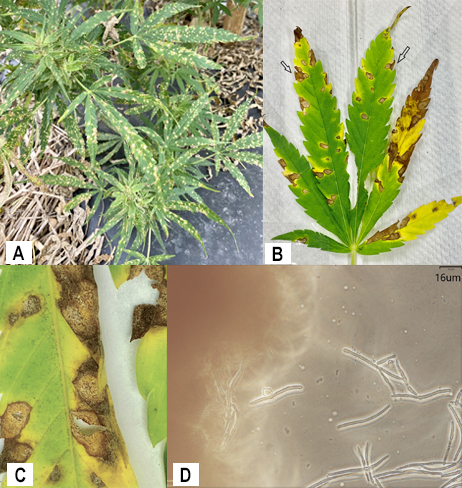
Figure 1. Yellow leaf spot symptoms and signs. A) Yellow leaf spot caused by Septoria spp. on field-grown hemp B) Arrows indicate brown irregular spots with yellow halos C) Leaf spots with dark colored pycnidia D) Septoria spores being released from the pycnidia as viewed under a compound microscope. Photos: Nimmi Rajmohan.
Hemp Leaf Spot or Bipolaris Leaf Spot
Hemp leaf spot emerged in 2014 with the reintroduction of hemp production in the United States and has become widespread. Severe disease and extreme yield losses were reported in Kentucky. This disease starts as tiny, dark, necrotic spots on infected leaves. The spots typically have a tan center and dark brown margins. Multiple lesions may merge (coalesce) to cause leaf blight, which may cause the leaf to turn yellow and defoliate prematurely. Dark conidiophores (stalks that produce dark cigar-shaped conidia) are visible in the centers of spots on both upper and lower leaf surfaces. Symptoms begin to appear in August.Warm, wet weather favors disease onset and development. Bipolaris spp. has also been found to infect grass and weed hosts, such as Acalypha ostryifolia (hophornbeam copperleaf), Microstegium vimineum (Japanese stiltgrass), and Eleusine indica (Indian goosegrass) in Kentucky. Drechslera gigantea, belonging to the genus Bipolaris, has been identified as the pathogen causing Hemp leaf spot in Kentucky. Cultural practices for mitigating Hemp leaf spot include crop rotation, weed control, and increasing plant spacing within and between rows to improve air flow to allow for rapid leaf drying. Deep-tilling infested fields after harvest to ensure that plant debris stays buried will also help reduce the spread of the disease.
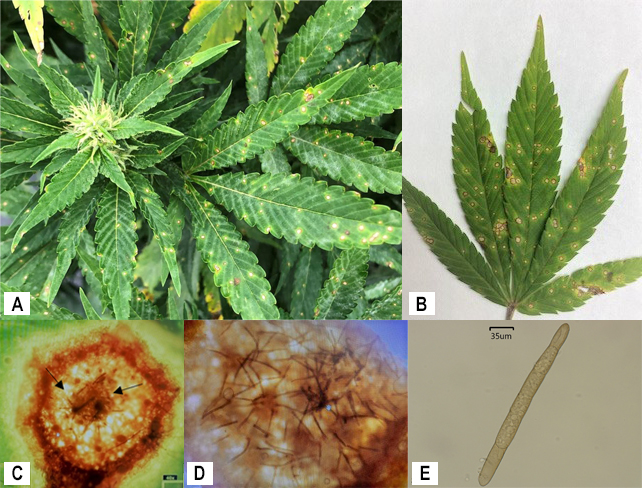
Figure 2. Hemp leaf spot. A) Hemp leaf spot caused by Bipolaris spp. on field-grown hemp. Photo: Raul Cabrera
B) Individual leaf showing light brown/tan lesions with tan borders. C) Magnified view of a leaf spot with dark conidiophores visible in the center of the leaf spot, indicated by arrows, viewed under a compound microscope. D) Magnified view of Bipolaris spp. conidiophores and conidia E) Conidium of Bipolaris spp. viewed under a compound microscope. Photos: Nimmi Rajmohan.
Cercospora Leaf Spot
Cercospora leaf spot is caused by the fungus Cercosporas spp. This fungus causes circular to elliptical spots, with gray centers and dark brown-black margins. Symptoms generally start on older leaves and eventually spread throughout the canopy. Lesions turn light tan, or even white, with yellow halos. Severely infected leaves usually develop chlorosis (yellowing), which leads to premature defoliation. Cercospora produces pseudostromata (tiny black dots) that form in leaf substomatal cavities within the grayish-tan lesions. The pseudostromata produce conidiophores (conidia bearing structures) that are borne in clusters in the center of the spot. Pseudostromata are visible with a hand lens and are a good diagnostic feature. Conidia easily move through wind and in free moisture. The primary source of inoculum for this disease is residue from a previously infected crop. Cercospora cf. flagellaris was identified as the pathogen causing Cercospora leaf spot in Florida. The pathogen has a wide host range with reports on plant species from 24 different families, including soyabean and melon. Cultural practices for mitigating Cercopsora leaf spot include crop rotation, weed control, and increasing plant spacing within and between rows to improve air flow to allow for rapid leaf drying. Any plant debris should be buried or removed from the site after harvest to help mitigate the spread of the disease.

Figure 3. Cercospora leaf spot symptoms. A) Dark lesions on an individual leaf. B) Arrows indicate conidiophore bearing conidia on Cercospora spp. infected leaf as viewed under a dissecting scope. C) Conidium of Cercospora spp. viewed under a compound microscope. Photos: Nimmi Rajmohan.
Brown Leaf Spot
Brown leaf spot is caused by Phoma spp. Infections result in light brown leaf spots with concentric rings. These infections are most common during wet, cool conditions, and can survive in soil and old plant debris. These fungi can also form pycnidia that produce conidia (spores). Conidia are moved to uninfected plants from overwintering sites by splashing water, equipment, and human beings during wet weather. Pycnidia are easily seen within the leaf spots in concentric rings. Brown leaf spot rarely kills the plant but can reduce the yields. Cultural practices for mitigating Brown leaf spot include crop rotation, weed control, and increasing plant spacing within and between rows to improve air flow to allow for rapid leaf drying. Ensuring that plant debris is buried or removed after harvest will help to mitigate the spread of the disease.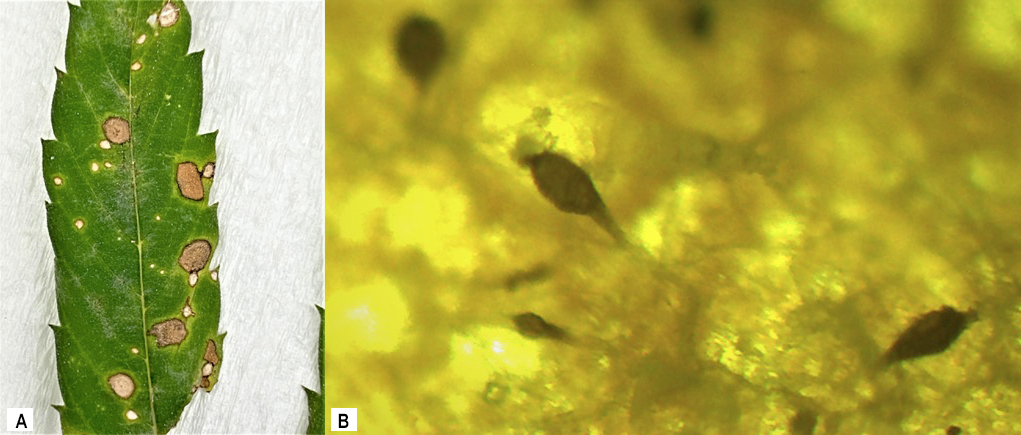
Figure 4. Brown leaf spot symptoms. A) Brown leaf spot symptoms on Hemp leaf. B) Fruiting structures which carry conidia as viewed under a compound microscope. Photos: Nimmi Rajmohan.
Powdery Mildew
Powdery Mildew is a common foliar disease of hemp. It is different from the other leaf spot diseases and appears as white patches on the leaf surface. During the growing seasons of 2020 and 2021, powdery mildew symptoms were observed during the summer months (Jun. to Aug.) in greenhouse hemp research and fall months (Aug. to Oct.) in field production plots on Rutgers NJAES farms in southern and northern New Jersey. Symptoms were observed on leaves and stems of hemp cultivars ‘CB Genius’, ‘Cherry Wine’, and ‘Bay Mist’. Symptoms initially appeared as white patches of mycelia and conidia on the upper surface of leaves that gradually spread to entire leaves and stems. Leaf discoloration and premature leaf drop were observed. More severe symptoms and damage were observed in the greenhouse than outdoor cultivation. Powdery mildew pathogens are generally host specific. Golovinomyces sp. (synonym Erysiphe sp.) is the most common of the powdery mildew pathogens that infect hemp.

Figure 5. Powdery Mildew symptoms. A) Heavy Powdery mildew infection on a susceptible Hemp plant. Photo: Michelle Infante-Casella.B) White patches of mycelia and spores visble on a Hemp leaf. C) Spores of Golovinomyces ambrosiae as viewed under a compound microscope. Photos: Nimmi Rajmohan.
Non-Leaf Spot Diseases
Botrytis or Gray Mold
Botrytis or Gray Mold is caused by the fungus Botrytis cinerea. Gray mold is favored by high humidity, poor airflow, and moderate temperatures. It is an opportunistic pathogen that easily invades weak, damaged, or senescing tissue. This fungus is very common in the Pacific Northwest. It was observed in greenhouse and field-grown hemp in New Jersey during the 2020 and 2021 growing seasons. Infection is most common in flower buds but can be observed on all plant parts. Gray mold can cause brown, water-soaked lesions on different parts of the plant, including stems, leaves, and flowers. Leaf and flower lesions eventually become necrotic and produce a mass of gray, grape-like conidia. Botrytis generally enters through a wound or opening in plant tissue. Black sclerotia may develop in diseased tissues, which allows the fungus to overwinter in dead plants and plant debris. Botrytis cinerea may also cause damping-off in small seedlings or cuttings in the greenhouse when conditions are cool and wet. Plants may girdle at the soil line and roots become necrotic and water-soaked.
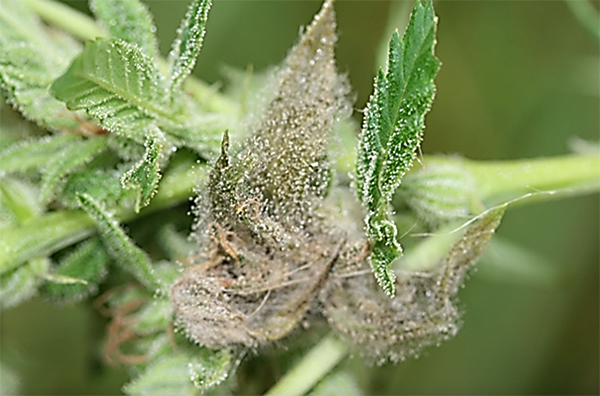
Figure 6. Botrytis gray mold symptoms. Gray fuzzy Botrytis spores on Hemp. Photo: Stephen Komar.
Fusarium Bud Blight and Flower Blight
Fusarium bud blight and flower blight symptoms include yellowing and necrosis of flower parts. This was mainly observed in the field during the 2020 and 2021 growing seasons. The fungus produces abundant white mycelial growth on the flowers. Several Fusarium species have been implicated in flower blight on hemp, including F. equiseti, F. proliferatum and F. graminearum. Fusarium graminearum was identified by DNA sequencing as the pathogen causing flower blight in New Jersey. The pathogen overwinters on infested crop residues and other host plants. On infested residue, the fungus produces asexual spores called macroconidia, which are dispersed to plants and other plant debris by rain-splash or wind. F. graminearum is known to cause head blight on wheat and ear rot on corn. F. graminearum produces mycotoxins like deoxynivalenol (DON) and zearalenone, which exhibit acute toxic effects in humans. It is therefore important to test for mycotoxin levels in hemp grown for human consumption.
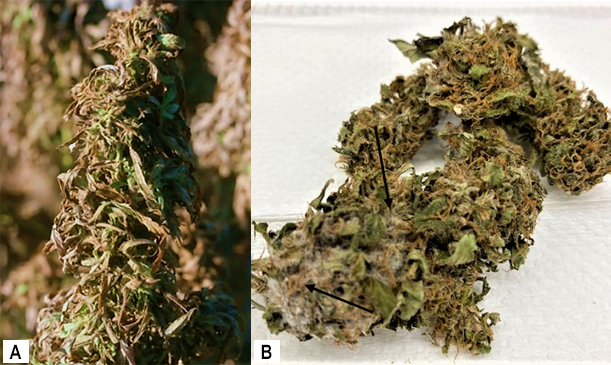
Figure 7. Fusarium flower blight symptoms A) Yellowing necrotic flower parts and leaves on field Hemp. Photo: William Bamka. B) Infected flower and bud of hemp, arrows indicate white mycelial growth. Photo: Nimmi Rajmohan.
Disease Management
This document is aimed at presenting information about emerging New Jersey Hemp diseases and their management. Updated information will be provided as new diseases are identified in the state. The U.S. Environmental Protection Agency has expanded the number of pesticides approved for hemp cultivation since its initial guidance was released in December 2019. The expanded list now includes just one conventional pesticide and 58 biopesticides. The link to this list is included in the Additional Resources section of this document. There are currently only a few of these non-conventional fungicides approved for use on hemp in New Jersey, all of which are biopesticides. Furthermore, additional research is needed as efficacy data for these materials in New Jersey cropping systems is not available. While pesticides are an important tool for disease management, they are just one of many tools available. An integrated approach to disease management in commercial hemp production is key, with modification of cultural practices and cultivar selection being the primary methods to mitigate disease incidence.
Season-long best management practices for:
- Pre-plant for greenhouse or field production
- Purchase only disease-free plant material or clean seed from a reputable source.
- Only use new pots and potting media. If recycling pots, they must be cleaned and sterilized.
- Quarantine newly arrived plant material for 2-3 weeks in a separate space.
- Cleaning and sanitizing surfaces in greenhouse as well as field equipment in preparation for seeding/transplants or field preparation.
- Never reuse planting medium for transplant production or for crops started from seed.
- During the production season (field)
- Maximize air flow in the plant canopy with proper row spacing and row orientation.
- Avoid overhead irrigation or excessive watering.
- Time irrigation events for morning to allow for the rapid drying of leaves.
- Monitor soil moisture levels. Avoid overwatering.
- Carefully prevent excessive, rapid plant growth (monitor nitrogen fertility to prevent excessive growth, especially N).
- Avoid physical injury to the plant.
- Scout, monitor, and control insect pests.
- Control weeds, especially those that may serve as alternate hosts for pests and diseases.
- Properly treat infested or infected plants and those nearby.
- Maintain weed-free fields by growing on plastic mulch or black landscape fabric.
- Remove and destroy infested plant material by burning (requires a burning permit) or burying.
- Sanitize equipment and tools between use.
- During the production season (greenhouse)
- Maximize air flow in the plant canopy with proper row spacing and row orientation.
- Avoid overhead irrigation; use drip irrigation to keep leaves dry.
- Avoid overwatering the soil to help prevent root rot development.
- Avoid physical injuries to plants.
- Scout and monitor for and control insect pests and diseases.
- Regular maintenance of crop debris.
- Post-harvest (field)
- Plow-down infested plant material (if burning, obtain burning permit).
- Rotate away from hemp fields for 3 to 4 years with legumes.
- Control weeds, especially those that serve as alternate hosts for insect pests or diseases.
- Sanitize equipment and tools between use.
Sanitation
Due to the limited availability of registered fungicides for preventative or curative control of hemp plant diseases, preventative measures must be an important component of any disease management system. Sanitation, both in-field and in the greenhouse, can be an effective method to reduce pathogen inoculum and disease spread. An effective sanitation program will include regular scouting and monitoring of the growing area throughout the year.
Field Sanitation Practices
- Properly wash farm implements before moving to a new field.
- Limit moving through fields when plants or soil are wet.
- Remove diseased plants from field and effectively destroy plant material.
- Properly clean tools and hands with approved solutions to reduce pathogen spread.
Greenhouse Sanitation Practices
- Maintain clean floors free of soil or plant debris. When possible, use concrete, gravel, or covered soil to reduce disease transmission.
- Maintain effective weed control measure inside the greenhouse.
- Clean and sanitize all work surfaces, benches, and tools to minimize inoculum spread.
- Remove diseased plant material.
- Maintain proper biosecurity protocols before entering the greenhouse, including plant screenings, clothing and boot washing, and proper hand washing.
Additional Resources
References
March 2023
Copyright © 2024 Rutgers, The State University of New Jersey. All rights reserved.
For more information: njaes.rutgers.edu.
Cooperating Agencies: Rutgers, The State University of New Jersey, U.S. Department of Agriculture, and Boards of County Commissioners. Rutgers Cooperative Extension, a unit of the Rutgers New Jersey Agricultural Experiment Station, is an equal opportunity program provider and employer.

